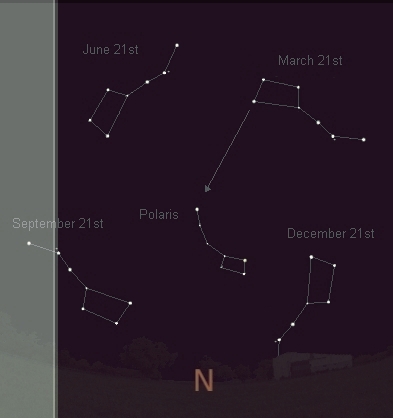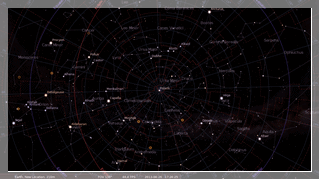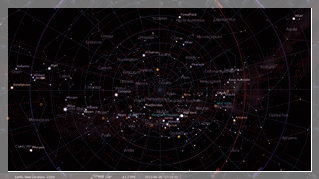Touring the Night Sky

First of all, you'll need to consider what's the latitude of where you're observing. The sky at your disposal is fundamentally not the same, should you be in the northern hemisphere, the tropics, or South! Then the season at which you're meaning to get initiated into the night sky. Most of what follows may be found back, more detailed in the main pages of the site! Thence just follow the guide!
At last, in any case, read the three following remarks, which are mandatory for a better use of our tutorials:
- note #1: we assume that you know where the South, North, West and East are, relative to your observation location (that's easily found with a compass, or with a chart). The charts, further, are given for 10:30 p.m. local time -which is the usual time for which the night sky charts, usually, are given. The detailed color charts are added with printer-friendly charts as it's mostly those latter ones that you'll like to take with you on the field
-note #2: you will note that, as far as our site's charts are concerned, they do not bear, by a worry of legibility, any name of the bright stars. As our description refer to such names, just consider that those mostly are, on the chart, the brightest star of a constellation in question
- note #3: you'll note that you may have to apply some correction to any chart, function of the DST or ST you have at your location. Our site is applying a uniform 1-hour DST time shift, from April to October in the northern hemisphere, with the charts reflecting that choice
- note #4: a current tendency of the astronomical softwares and charts is to shift from the constellations' shapes as they are usually defined and recognized by the amateur astronomy community. The following color charts on this page are those which are shifting the most in this regard, as the printer-friendly charts are those who do less and are the ones to be used to memorize the basic shapes of the constellations, albeit still not completely accurate. read more!
| Night Sky Basics Touring the Night Sky |
Hemispherical Sky Charts |
The northern night skies were the first to be thoroughly studied and theorized, as it's at the time of the Great Discoveries only that the explorers got beyond the tropics, to the southern skies. Each of those skies are ruled by some basics
| Northern Skies Tropical Skies |
Southern Skies |
The northern skies are those which the Babylonian, Egyptian, or Greek astronomers studied since the highest Antiquity. They are home to the most famed and fine constellations, like Orion, the Hunter, Andromeda, Andromeda, Taurus, the Bull, or Leo, the Lion! The northern hemisphere, on the other hand, is home to the Polaris, and the Great Bear, those features which allow for the first steps into the night. Any casual observer should begin by spotting those, like a preliminary
 | click to locations of the Great Dipper according to the seasons |
Ursa Major, the Great Bear, is especially seen under the form of the asterism of the Great Dipper. Knowing where to see it is a standard of amateur astronomy. Alignments using its stars allow to find other constellations and it's a fine scenery. In the northern hemisphere, The Great Dipper is always more or less in the direction of the North. To find the general direction where to look just use this chart which is showing where the Great Dipper is about 10:30 p.m. along the year (some form of latitude may be accepted function of whether any DST system is applied, for example). The Great Dipper is generally sketched like having the form of a saucepan or of a dipper. The three stars forming a curve are like the handle of the saucepan or of the dipper as the four others are the saucepan or the dipper themselves. The form of a bear is only explained by other stars which are part of the constellation Ursa Major. The Great Dipper is useful to find the Polaris, this star which is marking the North and about which the sky seems to be spinning. Just spot the two stars forming the right edge of the saucepan and extend the line they are forming upwards of the dipper. The first, lone, relatively bright, star which is found along the line is the Polaris. Should you wait some time enough facing this star you would notice that stars being at your right have risen above the horizon as those located at your left have dipped. This is due to Earth's axis being directed to the Polaris and Earth rotating eastwards. The night sky is appearing rising East and setting West, rotating about the Polaris. On the other hand, the Polaris is part of another, smaller, saucepan, which is the Little Dipper, or Ursa Minor, the Little Bear

 | click to finding Cassiopeia |
As the equator and the tropical regions are situated midway the northern and southern parts of the celestial sphere, the resulting sky, there, is not a partly northern, partly southern sky, but, better, subtle skies where northern and southern skies are blending in interesting figures. A striking feature, at the tropics, is that, each day, all year long, the Sun is rising at about 6:00 a.m. local time, as it is setting all year long at about 6:00 p.m. The direction at which the Sun is rising or setting, on the other hand, leads to the shortness of the twilight, with a rapid transition from day to night, and from night to day
Like for the northern or southern hemispheres, some developments are useful about the Polaris or the Southern Cross albeit they strictly not are used as a mean to locate the north or south celestial pole. The Polaris is just North on the northern horizon as the south celestial pole is just South on the southern horizon. The celestial equator is running overhead East-West. Once this direction verified with a compass or a map, the south celestial pole is just South, on the horizon as the north celestial pole is just North on the horizon
 | click to the Great Dipper and the Polaris at the equator |
The north pole is further indicated by the Polaris which is literally lying on the horizon -and sometimes below- hence difficult to see. A way to guess where it is is to use the trick used in the northern hemisphere to find it, that is the Great Dipper. At the equator this trick is useful from mid-January to mid-June only as, outside this period, the Great Dipper is not visible for this purpose. The Great Dipper is an asterism, part of the constellation Ursa Major, the Great Bear. The Great Dipper is a quadrilateral at the top left spike of which an arch of 3 stars is extending. The accompanying chart is showing the Great Dipper positions from February, 1st to June, 1st. Once accustomed to the method, you will be able to use it 15 days before and 15 days after. Once the Great Dipper spotted just look for the two stars which makes the outer, righmost edge of the quadrilateral. The Polaris is just at the end of a line extended from these. Strictly, the Polaris is not always visible on the horizon since it is not exactly at the north celestial pole. Hence it has a proper apparent motion. It is not visible, at the observation hours, between mid-April and the end of June. The Polaris is part of the constellation of Ursa Minor, the Litlle Bear, which is better seen like a Little Dipper. The Little Bear itself is not visible between the beginning of September and mid-March
As far as the south celestial pole is concerned, it bears no landmark identical to the Polaris. Southerners are using Crux, the Southern Cross instead. It's an imperfect tool however as the Southern Cross in under the horizon from mid-September to early December. At the equator the Cross is unusable from about after July, 8th until about February, 1st. Crux, the Southern Cross is a small constellation embedded in the Milky Way. Its shorter axis is wide like both stars either side of Altair. Its main axis is pointing to the south pole
 |  | click to Crux, the Southern Cross, showing the south celestial pole (left) and to Canopus as an additional mean to the Southern Cross (right) |
The first accompanying chart will help you to find it. On the other hand an additional method is used in the southern hemisphere. It's unavailable too during a part of the year. It's using Canopus (a of Carina, the Ship's Keel). It is one quarter of sky off the Southern Cross, at the same distance from the pole than the latter. Just draw a line from Canopus to the line determined by the Cross' main axis. Where the two lines meets at about an angle of 90°, there fairly is the south pole. Canopus, at the tropics and the equator, is useable, along with Crux, the Southern Cross, between about February 1st and about April 20th only
The main characteristics of the southern skies is that they mostly are inverted compared to the northern hemisphere. The most distinctive feature of the southern skies however is a remarkable band of Milky Way-embedded, typically southern constellations, which runs from Canis Major, the Great Dog to Aquarius, the Water Bearer. That band is taking various positions relative to the south celestial pole, along the seasons. Most of the constellations South, on the other hand, were recognized and named by European explorers from the 16th century onwards
 | click to where Crux, the Southern Cross is along the seasons |
As the Great Dipper and Polaris allow to spot the celestial pole -hence North- in the northern hemisphere, the southern hemisphere is lacking such easy beacons. The famed Crux, the Southern Cross just fix that, in an imperfect way however. Crux is a cross-shaped constellation as the main axis of it is pointing to the south celestial pole. Should you want to find Crux, just turn South! Remember: South is left of where the Sun is generally setting (or use a compass)! Crux, the Southern Cross is a small constellation which is to be found in the Milky Way. Its shortest length equals the distance which separates both stars located each side of Altair, in the constellation Aquila, the Eagle. Crux' main axis is pointing South! The main inconvenience with Crux is that the constellation isn't visible during a relatively lengthy part of the year, as it passes under the southern horizon, from September 10th to about December 25th and that there's no alternative method. A helpful feature however may reside into the bright Canopus, along with Crux' axis. Canopus is the star a Carinae. It's located at a quarter sky length from Crux, and at the same distance from the south celestial pole than it (in both accompanying charts, Canopus is the brightest star, the two stars nearest to Crux, the Southern Cross excepted). Now, imagine a line which leaves Canopus, intersecting at a 90° angle the line determined by Crux' axis. The intersection is just the south celestial pole! Canopus however, as far as it is concerned, is not observable neither from after the beginning of June to the beginning of October. Hence southerners are just left with Crux and Canopus from the end of December to the beginning of June, and with Crux only from the beginning of June to September 10th. They, at last, are left with no hint to the southern celestial pole between September 10th and the end of December (note: the data, in terms of dates, as far Crux, the Southern Cross and Canopus are concerned, may vary function of whether a DST system is enforced, or not, from where you are observing)
 | click to Crux and Canopus along the seasons (for the constellations' shape, if needed, see at the appropriate seasons) |
| Northern Hemisphere Tropics |
Southern Hemisphere |
It may be assumed that each season, in the northern hemisphere, comes with its pattern of constellations and stars. Winter sky is the sky of great and fine constellations such as Orion, Canis Major, the Great Dog, and Gemini, the Twins. Spring is featuring Hydra, the Hydra, and Bootes, the Herdsman. During summer, it's the Summer Triangle and the center of the Milky Way Galaxy which is ornating the skies. And, eventually, in fall, the Great Square of Pegasus and Andromeda, Andromeda are due South
The best way to keep your night skies tour is now to head to our 'Naked-Eye Sky Learning' tutorials, and specifically the one dedicated to the northern hemisphere. Just skip the passage about the The Great Dipper, Polaris, Cassiopeia you already learned to know, and just consider the five other sections, from 'Winter Sky' to 'Circumpolar Constellation'. Here you have, with the matching sky charts, some easy tutorials to get into the sky. How to use those? Just follow the directives given, and with the charts. You should make your way easily. Observations tips are given for night's first part, that is about 10:30 p.m. local time and don't forget our DST policy (see above). A last hint: don't get impressed with those detailed tutorials, and just cling to the journey like proposed
Like in the northern hemisphere, the skies come into four main configurations, according to the time of the year when you'll observe
The best way to keep your night skies tour is now to head to our 'Naked-Eye Sky Learning' tutorials, and specifically the one dedicated to the tropics. Just skip 'North, South' dedicatdd to the Polaris and Crux, and use the other sections, from 'Winter Sky' to 'Autumn Sky'. Here you have, with the matching sky charts, some easy tutorials to get into the sky. How to use those? Just follow the directives given, and with the charts. You should make your way easily. Observations tips are given for night's first part, that is about 10:30 p.m. local time and don't forget our DST policy (see above). A last hint: don't get impressed with those detailed tutorials, and just cling to the journey like proposed
Like in the northern hemisphere, the skies come into four main configurations, according to the time of the year when you'll observe, with the large, fine band of Milky Way-embedded constellations the most obvious marker
The best way to keep your night skies tour is now to head to our 'Naked-Eye Sky Learning' tutorials, and specifically the one dedicated to the southern hemisphere. Just skip 'Crux and Canopus' dedicated to the question of the southern celestial pole, and use the other sections, from 'Winter Sky' to 'Autumn Sky'. Just remember the season, in the southern hemisphere are the contrary of those seen North. Their winter is corresponding to the northern summer, etc. Just use, with the matching sky charts, some easy tutorials to get into the sky. How to use those? Just follow the directives given, and with the charts. You should make your way easily. Observations tips are given for night's first part, that is about 10:30 p.m. local time and don't forget our DST policy (see above). A last hint: don't get impressed with those detailed tutorials, and just cling to the journey like proposed
Those two hemispherical maps are a further bonus with the pack. Such hemispherical sky charts are much usual tools with amateur astronomers. With a limiting magnitude of the 6th magnitude, they provide a comprehensive view of both the northern and southern parts of the celestial sphere, allowing for some swift check of a position or the general approach of the whole celestial sphere
 |  | click on the chart (left) to a northern hemispherical sky chart or the chart (right) to a southern hemispherical sky chart |
->Feeling interested by the hobby? See more subjects, and detailed studies, at the site 'Amateur Astronomy'!
Website Manager: G. Guichard, site 'Amateur Astronomy,' http://stars5.6te.net. Page Editor: G. Guichard. last edited: 12/28/2010. contact us at ggwebsites@outlook.com